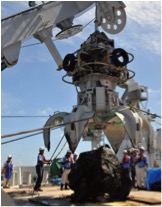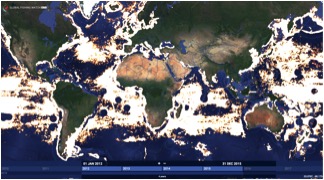- Marine scientists from University of California, Santa Barbara share their top 10 list of game changing developments for the ocean in 2016.
- Massive new ocean protected areas and transformative policies to fight illegal fishing brought hope.
- The world’s worst coral bleaching event, record sea ice lows, and coastal flooding revealed the ever-growing influence of climate change.
- This post is a commentary. The views expressed are those of the author, not necessarily Mongabay.
In 2016, massive new ocean protected areas and transformative policies to fight illegal fishing brought hope.
Meanwhile, the world’s worst coral bleaching event, record sea ice lows, and coastal flooding revealed the ever-growing influence of climate change.
Here are the top 10 developments of 2016 that will impact the health and safety of Earth’s oceans.
1. The Great Barrier Reef didn’t die. But it tried hard.

This year a tongue-in-cheek article claiming the Great Barrier Reef had died went viral. Its circulation inspired lamentations from many who had “diving the Reef” on their bucket list. The good news is that the Great Barrier Reef, one of the largest living structures on our planet, didn’t die in 2016. The bad news is that it took a serious beating.
This year was the world’s worst bleaching event on record and was a continuation of a global bleaching disaster that started in 2015. Corals around the world have been impacted. An estimated 67 percent of the corals in the northern third of the Great Barrier Reef died. The bleaching was caused by record high temperatures. These ocean heat waves broke down the healthy mutualism between corals and the microscopic algae that live within their tissue. These algae imbue corals with color and provide them with an important source of photosynthetic energy. This year was an unfortunate instance when real reef news was only marginally less scary than fake news.
2. New treaty to stop illegal fishing

The majority of the world’s fishermen work hard to follow an increasingly complex set of sustainability regulations. Their efforts are undermined by a small fraction of illegal fishermen that have had a big impact on ocean health. Illegal fishing has, for example, been estimated to be a $23.5 billion annual trade, representing up to 20 percent of fish caught in the ocean.
In June 2016 the world made a major stride forward in curtailing illegal fishing by bringing into force the Port State Measures Agreement. This pact makes it harder to offload illegal catch by requiring that vessels give notice of their arrival to port and allow inspections. Vessels suspected of illegal activity can be blocked entry into a harbor to fuel up or offload suspect catch. Port states are also required to share information on illegal fishing. Collectively these new measures will make it much easier to crack down on illegal fishing in the years ahead.
3. Cruising the Northwest Passage in Luxury

In 1850, Commander Robert McClure and his crew got trapped in the ice for three years while searching for the Northwest Passage. His expedition joined a long list of expeditions that endured considerable hardship searching for a much-sought-after northerly trade route that could connect Europe and Asia.
Things have changed in the intervening 150-plus years. Climate change rendered the Northwest Passage ice-free for the first time on satellite record in 2007. This year, the cruiseliner Crystal Serenity became the first-ever passenger cruise vessel to travel through the Northwest Passage — motoring 1,000 passengers in luxury from Anchorage to New York City in 32 days. The passage of the Crystal Serenity is emblematic of a whole suite of historically impossible commercial activities, from commercial fishing to oil extraction that may now be tenable in an increasingly ice-free Arctic. Proper management of these new Arctic enterprises will determine the future of this fragile and remote ecosystem.
4. Will 2017 be the first year we mine the deep sea?

Ocean mining may soon be more than just science fiction. In 2017, Japan plans to begin pilot-mining for zinc, silver, and other mineral resources in the Izena Hole, a site only 100 kilometers (62 miles) northwest of Okinawa.
Not far behind, Canadian company Nautilus Minerals plans to soon break ground on a project mining deep sea vents in Papua New Guinea.
Meanwhile, mineral prospecting activities are already underway in the Atlantic, Pacific, and Indian Ocean. Information on exactly when and where these prospecting activities are occurring was publicly shared for the first time this year.
5. Big Step forward in Antarctic conservation
In October of this year, the Commission for the Conservation of Antarctic Marine Living Resources (CCAMLR) protected 1.55 million square kilometers (598,000 square miles) of ocean in the Ross Sea off Antarctica. CCAMLR is an international organization that represents 24 countries and the European Union.

The Ross Sea Marine Protected Area, years in the making, was significant for the oceans on two important levels. First, this is the first protected area in Antarctica — a biodiverse region sometimes referred to as the ocean’s last wild frontier. Second, the move represents the first time nations have come together to protect an area of ocean outside of an individual nation’s national boundaries. This establishes a model that will be of great value to conservation initiatives currently being discussed in the United Nations concerning the possibility of establishing protected areas in other international waters. This matters, as the high seas account for over 60 percent of our global oceans.
6. World’s longest-living vertebrate… is a shark!

Using eye tissue and radiocarbon dating, scientists discovered this year that a five-meter-long (16-foot-long) female Greenland shark was the oldest living vertebrate on Earth. While her minimum estimated age was 272 years, experts believe she may have been closer to 400 years old.
Greenland sharks now take the lead over other impressively old vertebrates, including the bowhead whale and Aldabra giant tortoise. Findings like these highlight how much more there is to learn about our oceans and showcase the power of novel techniques for accelerating ocean discovery.
7. Big data on fishing
With over 37 billion points of data, Global Fishing Watch, launched in September of this year, allows anyone in the world to track many of the fishing vessels across the global oceans.

Previously, the capacity to observe fishing activity was controlled by governments using proprietary tracking systems. New tools like Global Fishing Watch represent an exciting new wave of progress that promotes the democratization of ocean data.
Opening up access to ocean big data allows conservation organizations, scientists, and policy makers to build smarter and more powerful management plans to safeguard ocean health.
8. World’s largest protected area… again
In August 2016, US President Barack Obama expanded the world’s largest protected area, the Papahānaumokuākea Marine National Monument in Hawaii. This 583,000-square-mile section of ocean provides a safe zone for monk seals, sea turtles, sharks, and myriad other at-risk wildlife. Several months later, the Ross Sea Marine Protected Area was established (see above) with a larger overall area than Papahānaumokuākea, but a slightly smaller no-take area that totally excludes fishing.

An equally impressive commitment was also recently made by Mexico to protect 650,000 square kilometers (250,000 square miles).
Globally, over 3.6 million square kilometers (1.39 million square miles) were protected in 2016. This brings the total amount of protected ocean to five percent. This was impressive progress, but represents still only half the amount called for by the Convention of Biological Diversity and a small fraction of what marine scientists believe will be needed to protect ocean health.
9. Discovery of the parking garage octopus
In Nov 2016, an octopus was discovered in the parking garage of a luxury seaside condo complex — a rather atypical habitat for this marine species. Local reporting indicated that flooding associated with unusually high tides carried the octopus up through garage drainage pipes.

Projections for sea level rise suggest this may be just the tip of the (melting) iceberg. Climate change is causing ocean waters to expand and melting land ice is adding more volume to the oceans, which are projected to rise about two feet by the end of this century. Much more alarming than marine wildlife in parking garages is the potential for trillions of dollars in damage that sea level rise may cause to coastal communities if climate change goes unchecked.
10. Climate change: Fixed and unfixed
This year began with ocean scientists celebrating unprecedented progress on slowing climate change. China ascended as a global leader on climate issues. US President Obama’s administration enacted the Clean Power Plan and put in place policies designed to cut methane emissions. Obama himself even took time out to snorkel on a coral reef to highlight the risks climate change poses to ocean ecosystems. But the true highlight of 2016 was when the Paris Agreement went into effect on November 4.
Four days later,however, the United States elected a President that may pull the US out of the Paris Agreement within a year. Doing so would significantly impact the amount of wind there is in the sails of these collaborative, international efforts to slow climate change. Decisions made in Washington, D.C. in 2017 may be the most important decision we ever make about the long-term health of our oceans.
